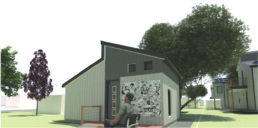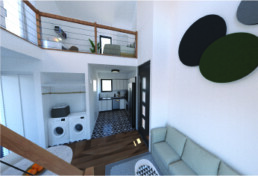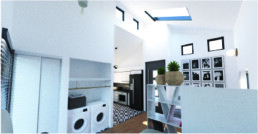Westhab Inc. Opens $73M Transitional Housing Complex in Brooklyn
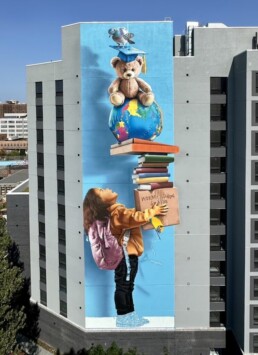
Westhab Inc. Opens $73M Transitional Housing Complex in Brooklyn
NEW YORK CITY — Westhab Inc., a nonprofit provider of housing and human services, has opened Fort Greene Family Center, a $73 million transitional housing complex in Brooklyn. Aufgang Architects designed the 11-story building, which houses 105 units and was developed in partnership with Slate Property Group. The building also features 1,405 square feet of community facility space and recreational areas for children. In addition, residents have access to a range of onsite social services: job training programs, financial literacy training, youth services and educational support, healthcare coordination and wellness programming.
Link to Orignal Article:
Westhab Inc. Opens $73M Transitional Housing Complex in Brooklyn
Partnership Breaks Ground on $254M Affordable Housing Project Near Downtown Brooklyn
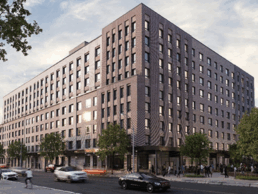
Partnership Breaks Ground on $254M Affordable Housing Project Near Downtown Brooklyn
Published by France Media Inc.
NEW YORK CITY — A partnership between Gilbane Development, Blue Sea Development and Artspace Projects Inc. has broken ground on the Brownsville Arts Center & Apartments, a $254 million affordable housing project that will be located on a city-owned tract at 366 Rockaway Ave. near downtown Brooklyn. The property will offer 283 units in studio, one-, two- and three-bedroom units that will be reserved for renters earning between 30 and 70 percent of the area median income. The Brownsville Arts Center & Apartments will also feature a 28,000-square-foot cultural arts center with a 3,440-square-foot, multi-purpose performance, rehearsal and studio space for community arts groups. Various city housing agencies and authorities have committed nearly $100 million in subsidized financing for the project, construction of which is expected to be complete in 2027.
Link to Orignal Article:
Partnership Breaks Ground on $254M Affordable Housing Project Near Downtown Brooklyn
Aufgang Architects Reports Nearly 9,000 Multifamily Units in New York City in Its Design Pipeline
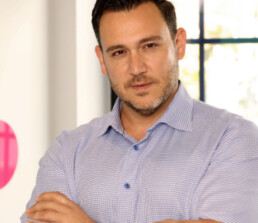
Aufgang Architects Reports Nearly 9,000 Multifamily Units in New York City in Its Design Pipeline
Aufgang, a leading New York architectural firm, has nearly 9,000 multifamily units in its design
pipeline throughout the City in various stages of development.
“Our substantial multifamily design pipeline includes affordable, supportive, senior and market rate projects for leading commercial real estate developers. We are committed to addressing New York’s housing crisis through thoughtful, environmentally sustainable designs for diverse communities.,” said Ariel Aufgang, AIA, Principal of Aufgang Architects.
“They are in a range of development from permit filings through nearly completed construction, providing much-needed homes for New Yorkers,” said Ariel Aufgang.
Aufgang is the second busiest architectural firm in NYC measured by new Department of Building permit applications, which totaled over 3.3 million square feet for the firm in 2024.
Ariel Aufgang identified some of his firm’s notable affordable residential design projects:
- North Cove Apartments on the Harlem River waterfront in Inwood, upper Manhattan, with 611 100% affordable units developed by MADDD Equities and Joy Construction
- Edgemere Commons in Rockaway, Queens, with 2,050 100% affordable units, many with ocean views, along with urban planning on a 9-acre site developed in multiple phases by Tishman Speyer. The first two Aufgang designed buildings are completed
- DWTN on Tillary Street in Brooklyn, with 473 units, developed by MADDD Equities and Joy Construction
- 450 affordable units in a residential building adjacent to the Kingsbridge Armory in the Bronx under an RFP approved by NYC EDC
- Kay’s Place nearing completion at 487 4th Avenue in Brooklyn is an 11-story, 44-unit building with affordable and supportive housing, along with ground-floor commercial space and an outdoor recreation area. This project is developed by Mercy Home and Procida Construction
Corp.
“We have approximately 45 multifamily design projects in four of the City’s boroughs, including about 3,000 units in each Queens and the Bronx, over 1,800 in Brooklyn and more than 800 units in Manhattan,” said Aufgang.
In the past decade alone, Aufgang has designed more than 13 million square feet of built space, comprising more than 13,000 residential units across more than 100 multifamily development projects, both market rate and affordable. These new construction and preservation projects were
capitalized at a total of approximately $3 billion.
Aufgang is known for its thoughtful, creative approach that also recognizes the importance of environmental sustainability in all aspects of design and engineering. Technology, including innovative proprietary artificial intelligence applications, enhances the firm’s ability to design comfortable, safe and sustainable multifamily buildings that meet its clients’ objectives.
Aufgang is a certified Minority Business Enterprise.
Link to Orignal Article:
Aufgang Architects Reports Nearly 9,000 Multifamily Units in New York City in Its Design Pipeline
Project 1B
Project 1
123HOME design proposal outlines a sustainable approach to the development of Accessory Dwelling Units in suburban towns. The main objective of the proposal is to respond to the current housing crisis by providing a budget friendly, sustainable, and aesthetic single-family home typology for a variety of users who are in need of a long-term living space. This strategy also simultaneously fosters community integration by increasing affordable housing options and diversifying the types of housing available for students, young professionals, families, and seniors, contributing to a more vibrant and diverse community fabric.
Professional Background: Vanessa bring
Position: As part of the Rehabilitation
Personal Life: Inform designing
123HOME design proposal outlines a sustainable approach to the development of Accessory Dwelling Units in suburban towns. The main objective of the proposal is to respond to the current housing crisis by providing a budget friendly, sustainable, and aesthetic single-family home typology for a variety of users who are in need of a long-term living space. This strategy also simultaneously fosters community integration by increasing affordable housing options and diversifying the types of housing available for students, young professionals, families, and seniors, contributing to a more vibrant and diverse community fabric.
123HOME design proposal outlines a sustainable approach to the development of Accessory Dwelling Units in suburban towns. The main objective of the proposal is to respond to the current housing crisis by providing a budget friendly, sustainable.
Professional Background: Vanessa bring
Position: As part of the Rehabilitation
‘We Cracked The Code’: First Hotel-to-Housing Conversion Using State Program To Open in Queens
‘We Cracked The Code’: First Hotel-to-Housing Conversion Using State Program To Open in Queens
A pandemic-era program aimed to facilitate hotel and office to affordable housing conversions. After a slow start, and numerous financing and design challenges, its first project is opening in Queens.
By Patrick Spauster
356 hotel rooms, double-loaded corridors, precast plank and concrete walls, a glass-enclosed pool, sheetrock walls, ribbon glass windows. These were the building blocks of the JFK Hilton Hotel, built in 1987, that operated for 35 years until it closed in 2023.
Architects cut, molded, and reconfigured those pieces to turn that behemoth structure into 318 affordable homes. Hundreds of formerly homeless residents will move in this fall.
The completion of construction earlier this month makes the development, called Baisley Pond Park, the first project
“I believe that everyone should have an amply sized apartment for their family size. There’s a crisis and people are on the street, right? If, in order to solve that problem, we first have to make buildings with 274 studio apartments that are the size of a hotel room, I think that’s a way to house our neighbors with dignity.”
-Ariel Aufgang, project architect
to open using the Housing Our Neighbors with Dignity Act (HONDA), a 2021 New York State law that financed the conversion of underutilized office and hotel space for affordable and supportive housing.
The incentives proved complicated to use, given the financial, architectural, and policy challenges involved with conversion projects. The Baisley Pond Park Project, built by a nonprofit and a developer in collaboration with multiple city agencies, cobbled together an innovative financing package from public and private sources.
More than half of residents—60 percent—will be formerly homeless families moving out of shelter, leveraging a development incentive from the Department of Social Services that helps pay rent in new affordable units by leasing up city voucher holders.
“We cracked the code on how to convert a hotel into a low income apartment building. It’s just a matter of getting the building at the right price,” said project architect Ariel Aufgang.
Baisley Pond Park Residences, in its infancy when the pandemic-era development incentives were made law, has emerged into a radically different market for hotels. But developers and architects hope that it demonstrates the potential of conversions at a time of a severe housing shortage, particularly for homes affordable to the lowest income New Yorkers.
An architectural jigsaw
There are a lot of rules when building housing. An affordable development like this needed legal amounts of light and air, larger bathrooms accessible to someone in a wheelchair, four burner stoves, full size refrigerators, and sinks.
Those necessities meant trading off living space in already-small hotel rooms. But the building had just enough natural advantages to make all those pieces work.
Hotels tend to be better suited than offices when converting to housing: they meet the legal requirements for light and windows in every room and hallways with rooms on each side—floor plans thin enough for so-called “double-loaded” corridors.
The bathrooms were already in the right place. While developers replaced aging parts of the plumbing, the shafts

carrying water up to the rooms would be usable for a bigger bathroom. And crucially, the bathrooms were in the right orientation: flat against the wall abutting the hallway.
A four foot corridor into the common space, opposed to three and a half, could change all the math.
“If you have a hotel that has the bathrooms oriented parallel to the hallway and you’re really tight between one bathroom and the next room’s bathroom, you might not get the space you need for an acceptable door,” described Aufgang.
It lent the room just enough width to convert into an apartment. A skinnier hotel room would have made the project impossible; the walls separating rooms were structural—they couldn’t be taken down to combine rooms.
The majority of the 318 rooms are studios—practical for converting from one and two bed hotel rooms—but also symmetrical with the building’s future tenants, formerly homeless individuals who are often single adults.
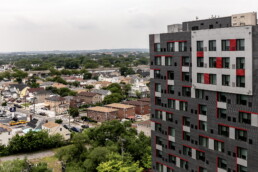
The building also has 33 one-bedroom and 10 two-bedroom units that wrap the corners and stitch together multiple single hotel rooms. With razor-thin margins to make affordable housing projects pencil out, some of the design is meticulous cost control, with each room slightly different.
“It’s just going space by space, room by room,” Aufgang said. “How do I make the doors big enough? How to make the bathrooms big enough? How do we try
to reuse the shafts to save money, reusing the windows to save money?”
After putting in full kitchenettes and ventilation, squeezed tight behind expanded bathrooms, there wasn’t a ton of living space left, especially in the studios, but enough for a bed and some furniture.
“The living spaces are small. There’s no question,” said Aufgang. He said that small apartments were the product of the building’s existing design, accessibility and habitability requirements.
But cost also drives design, especially in a city where building affordable housing is often prohibitively expensive.
“The answer seems to have been for the past few years to that, to try to solve the housing crisis, to keep making units smaller,” said Aufgang.

“I believe that everyone should have an amply sized apartment for their family size,” he continued. “There’s a crisis and people are on the street, right? If, in order to solve that problem, we first have to make buildings with 274 studio apartments that are the size of a hotel room, I think that’s a way to house our neighbors with dignity.”
Location, location, location
Tucked between two other hotels, the Baisley Pond Park building sits on an odd plot of land. Penned in on two sides by the Belt Parkway and the Van Wyck Expressway, it leans over highway and gazes over blocks and blocks of postage-stamp single family homes in South Jamaica.
The location has its pros and cons. It’s a bit remote. It’s mostly served by just one bus line, the Q40, with the nearest subway and commuter rail line at Jamaica Center, 2.7 miles to the north.
“It’s not a neighborhood where we’ve provided services before,” said Emily Kurtz, chief housing officer at RiseBoro, the nonprofit that will own and operate the site. But the scale of the project was attractive, Kurtz said, and meant they could more efficiently serve clients there.
So they invested in services on site, converting the building’s generous lobby and event space into a place to provide light-touch services to individuals and families living there.
A hotel restaurant became community rooms. The glass enclosed pool became an indoor garden, and the industrial kitchen was leased to Meals on Wheels. Hotel offices became headquarters for RiseBoro’s support services.
RiseBoro says it will add a shuttle service to transport residents from the facility to the Jamaica transit hub.
“It’s challenging because, you know, cost is a problem,” said David Schwartz, founder of Slate Property Group, the project’s developer. “We want to have a lot of affordable housing in transit rich neighborhoods and areas that have lots of infrastructure.”
“We have to take every opportunity to create units of affordable housing,” said Kurtz.
A spot a bit further out meant a lower purchase price that could facilitate the construction and conversion.
“We walked and looked at, you know, probably 100 to 200 hotels,” said Schwartz.
“It had to be large enough, the rooms had to be big enough to plug the [building code], the zoning had to work, the price had to work,” he said.
Those particulars, and complicated financing, were part of the reason the HONDA program got off to a slow start. One year after the program launched, New York Focus reported that it hadn’t dispersed any funds or started any projects.
Then, later in 2022, Gov. Kathy Hochul signed a law that lifted some of those onerous zoning restrictions, and permitted hotels within 400 feet of a residential district, plus those accessing HONDA funds, to be permanent residences.
Still, a now-booming hotel market in New York means the prospects for converting future sites could be slimming.
“A hotel is a little bit easier to convert than a commercial space into residences because the buildings tend to be double loaded,” said Aufgang, meaning they have rooms on both sides of a central hallway. “Sometimes buildings are just obsolete. So there’s just not enough you can do to make it worth it.”
A financial stack
One advantage of conversion: when the pieces do fit, you can do it faster.
“Our typical projects take 36 months just to do pre-development and then 24 to 36 months development, and this one was much shorter,” said Kurtz.
Part of that pre-development process is assembling the financing. For an affordable project like Baisley Pond Park, that means a complicated assortment of funding sources, factoring in equity from a developer, public subsidy, bonds, and ongoing operations. Developers call that delicate scaffolding of financing the “capital stack.”
Baisley Pond’s “stack” needed to add up to $167 million. They got a $50 million loan from the city’s Housing Development Corporation (HDC). They received another $48 million in HONDA funding. Usually, affordable projects use the go-to tool for building affordable housing in the United States: the Low Income Tax Credit. But that wasn’t going to work for a project and a program meant to serve New Yorkers fast.
“New York’s got a waiting list of five, six or seven years for low income housing tax credits,” said Schwartz.
Instead, since RiseBoro was going to own the project (often, affordable buildings are owned by developers and run and managed by nonprofits), the project was able to access bonds specifically for 501c3 nonprofits from HDC.
The ongoing operations of the site would be funded through the city’s Affordable Housing Services program, which fast tracks contracting and uses the future rent from city housing voucher holders in the building to fund operations.
The project took a perfect balance of the right building, the right program, and the right timing to come to fruition.
But developers, architects, and nonprofit operators hope that both the financing and the design and construction can be an example for future conversions.
“New York is complicated for construction,” added Aufgang. “You need time. 21 months is miraculous.”
The New York State Department of Homes and Community Renewal, which oversees the HONDA program, did not elaborate on how many projects may be in the HONDA pipeline. But it mentioned the completed JFK Hilton conversion and a Quality Inn conversion it funded in Ulster, New York.
“HCR continues to work closely with nonprofit partners throughout the state who are seeking to convert distressed hotels and underutilized commercial buildings to the safe, modern, and affordable housing New Yorkers need,” said a spokesperson for the agency in a statement.
“I think you can use this as a model,” said Schwartz. “Once you do it, I do think that this is a model that can be replicated.”
Adeline Angelino

Adeline Angelino
Job Captain
Arquitectura
Year Joined: 2025
Education and Certifications:
-
Bachelor’s Degree in Architecture, University of Miami 2025
Professional Background: Originally from New York, Adeline’s passion for architecture has been shaped by her diverse academic and internship experiences. While studying at the University of Miami, she developed a deep appreciation for minimalism and Japanese architecture, inspired in part by her study abroad program in Japan. She is particularly interested in exploring innovative solutions for creating eco-friendly and resilient cities. Adeline has worked at both a medium-sized firm specializing in educational buildings and a small design-build residential-focused firm.
Position: At Aufgang, Adeline supports design development, produces detailed drawings, and assists project teams in early‑phase planning and visualization.
Personal Life: Outside of work, Adeline enjoys hot yoga, experimenting with new cuisines, wheel throwing, jewelry making, and attending baseball games! She also loves to travel, and is always seeking inspiration from art, culture, and design around the world.
.
Project 1a
123Home
123HOME design proposal outlines a sustainable approach to the development of Accessory Dwelling Units in suburban towns. The main objective of the proposal is to respond to the current housing crisis by providing a budget friendly, sustainable, and aesthetic single-family home typology for a variety of users who are in need of a long-term living space. This strategy also simultaneously fosters community integration by increasing affordable housing options and diversifying the types of housing available for students, young professionals, families, and seniors, contributing to a more vibrant and diverse community fabric.
Our design proposal promotes sustainable development by utilizing the existing infrastructure to reduce urban sprawl, making efficient use of resources, and potentially reducing commuting time. The environmental footprint of the proposed unit is further reduced by incorporating energy-efficient systems, using sustainable, re-purposed and recycled materials, and on-site water conservation measures (rainwater collection, low-flow plumbing fixtures, recycled water system) in the building scale.
Professional Background: Vanessa bring
Position: As part of the Rehabilitation
Personal Life: When Vanessa isn’t designing
123HOME design proposal outlines a sustainable approach to the development of Accessory Dwelling Units in suburban towns. The main objective of the proposal is to respond to the current housing crisis by providing a budget friendly, sustainable, and aesthetic single-family home typology for a variety of users who are in need of a long-term living space. This strategy also simultaneously fosters community integration by increasing affordable housing options and diversifying the types of housing available for students, young professionals, families, and seniors, contributing to a more vibrant and diverse community fabric.
Project 4
Project 4
123HOME design proposal outlines a sustainable approach to the development of Accessory Dwelling Units in suburban towns. The main objective of the proposal is to respond to the current housing crisis by providing a budget friendly, sustainable, and aesthetic single-family home typology for a variety of users who are in need of a long-term living space. This strategy also simultaneously fosters community integration by increasing affordable housing options and diversifying the types of housing available for students, young professionals, families, and seniors, contributing to a more vibrant and diverse community fabric.
Our design proposal promotes sustainable development by utilizing the existing infrastructure to reduce urban sprawl, making efficient use of resources, and potentially reducing commuting time. The environmental footprint of the proposed unit is further reduced by incorporating energy-efficient systems, using sustainable, re-purposed and recycled materials, and on-site water conservation measures (rainwater collection, low-flow plumbing fixtures, recycled water system) in the building scale.
Professional Background: Vanessa bring
Position: As part of the Rehabilitation
Personal Life: When Vanessa isn’t designing
123HOME design proposal outlines a sustainable approach to the development of Accessory Dwelling Units in suburban towns. The main objective of the proposal is to respond to the current housing crisis by providing a budget friendly, sustainable, and aesthetic single-family home typology for a variety of users who are in need of a long-term living space. This strategy also simultaneously fosters community integration by increasing affordable housing options and diversifying the types of housing available for students, young professionals, families, and seniors, contributing to a more vibrant and diverse community fabric.
Project 3
Project 3
123HOME design proposal outlines a sustainable approach to the development of Accessory Dwelling Units in suburban towns. The main objective of the proposal is to respond to the current housing crisis by providing a budget friendly, sustainable, and aesthetic single-family home typology for a variety of users who are in need of a long-term living space. This strategy also simultaneously fosters community integration by increasing affordable housing options and diversifying the types of housing available for students, young professionals, families, and seniors, contributing to a more vibrant and diverse community fabric.
Our design proposal promotes sustainable development by utilizing the existing infrastructure to reduce urban sprawl, making efficient use of resources, and potentially reducing commuting time. The environmental footprint of the proposed unit is further reduced by incorporating energy-efficient systems, using sustainable, re-purposed and recycled materials, and on-site water conservation measures (rainwater collection, low-flow plumbing fixtures, recycled water system) in the building scale.
Professional Background: Vanessa bring
Position: As part of the Rehabilitation
Personal Life: When Vanessa isn’t designing
123HOME design proposal outlines a sustainable approach to the development of Accessory Dwelling Units in suburban towns. The main objective of the proposal is to respond to the current housing crisis by providing a budget friendly, sustainable, and aesthetic single-family home typology for a variety of users who are in need of a long-term living space. This strategy also simultaneously fosters community integration by increasing affordable housing options and diversifying the types of housing available for students, young professionals, families, and seniors, contributing to a more vibrant and diverse community fabric.
Project 2
Project 2
123HOME design proposal outlines a sustainable approach to the development of Accessory Dwelling Units in suburban towns. The main objective of the proposal is to respond to the current housing crisis by providing a budget friendly, sustainable, and aesthetic single-family home typology for a variety of users who are in need of a long-term living space. This strategy also simultaneously fosters community integration by increasing affordable housing options and diversifying the types of housing available for students, young professionals, families, and seniors, contributing to a more vibrant and diverse community fabric.
Our design proposal promotes sustainable development by utilizing the existing infrastructure to reduce urban sprawl, making efficient use of resources, and potentially reducing commuting time. The environmental footprint of the proposed unit is further reduced by incorporating energy-efficient systems, using sustainable, re-purposed and recycled materials, and on-site water conservation measures (rainwater collection, low-flow plumbing fixtures, recycled water system) in the building scale.
Professional Background: Vanessa bring
Position: As part of the Rehabilitation
Personal Life: When Vanessa isn’t designing
123HOME design proposal outlines a sustainable approach to the development of Accessory Dwelling Units in suburban towns. The main objective of the proposal is to respond to the current housing crisis by providing a budget friendly, sustainable, and aesthetic single-family home typology for a variety of users who are in need of a long-term living space. This strategy also simultaneously fosters community integration by increasing affordable housing options and diversifying the types of housing available for students, young professionals, families, and seniors, contributing to a more vibrant and diverse community fabric.






